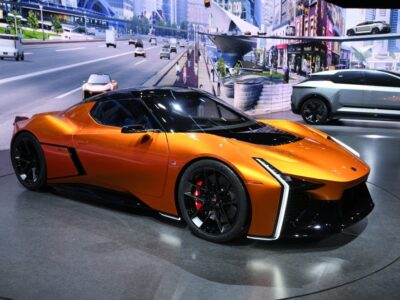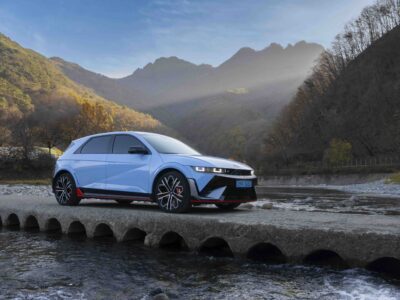(Bloomberg) —
Those who craft their identity around driving the most esoteric electric car may be having a frustrating year. Teslas are basically Chevys now. Hummers are borderline ho-hum. The coolest, or at least most current, neighbors at the cookout are bragging about their VinFast.
As the nascent US EV market continues to swell, 10 new models have gone on sale in recent weeks, bringing to 51 the number of battery-powered cars and trucks Americans have to choose from. That’s far fewer than the hundreds of models on offer in China or the 80-plus available in many European countries, but it’s growing quickly. At this time 12 months ago, the US only had about 30 models.
“I do believe we’re beyond the point of no return,” says Brian Collie, senior partner and head of the auto unit at Boston Consulting Group. “If you look at where the [automakers] are prioritizing their best designers, their best engineers, their best technologists — it’s all electric vehicles.”
The recent product blitz, however, is still at the margins of the market. EVs accounted for 7.3% of new-car sales in the US in the second quarter, according to S&P Global. And most of the new vehicles are either luxury sleds or models from startups with little manufacturing track record.
To learn more about all of the models currently available in the US, check out Bloomberg Green’s Electric Car Ratings. Here’s a look at what’s on offer as of this year.
BMW i5 and i7 | The Better, Best
German brands that make up the heart of the luxury segment continue to flood the zone on EVs. BMW is now shipping the i5 and larger i7 – two electric sedans that join the i4, its starter electric car, and its iX electric SUV, which debuted in late 2021.
With the i5, BMW is aiming for a Goldilocks sedan. It goes 295 miles on a charge — a little farther than the base model i4 — and carries a bit more stuff. Of course, it costs a bit more, too ($66,800).
The i7 climbs even higher up the socioeconomic hill. It commands $105,700, which buys a massive battery good for 321 miles, as well as a host of opulent details, like a sunroof veined with an LED light show.
Mercedes EQE SUV | The Peoples’ Benz
Mercedes is staying a step ahead with the launch of the EQE SUV, its fifth fully electric US model. (That makes three SUVs and two sedans, for those keeping score.) Starting at $77,900, the EQE SUV is essentially the electric version of the Mercedes GLE, one of the brand’s top-selling models.
The EQE’s bulbous body can go 279 miles on a charge, sacrificing a little range compared with the sedan version. But its interior offers the same spaceship vibes, with accent lighting that pulses in step with the accelerator and a massive center screen that overlays direction on a live video feed of the road ahead.
Audi Q8 e-tron and e-tron Sportback | The Young Adults
In another indicator of the EV market maturing, Audi is ditching its seminal e-tron, a midsize SUV, in favor of a more segmented product line.
The company already has the Q4 e-tron, an entry-level SUV, and now it’s slotting the Q8 and e-tron Sportback above it — two larger, swankier Costco-capable cruisers. They are essentially the same vehicle, but the roofline on the Sportback swoops down to the rear of the car, making for a more sporty silhouette and more slippery aerodynamics.
Both models come with a hefty 114 kWh battery and price tags starting at $74,400. That’s a lot of money, even in today’s auto market, but is also in line with what Audi charges for its gas-powered Q8s, yet another sign of maturity in the EV market.
Genesis Electrified GV70 | The Looker
Genesis has taken the shortcut to battery power, simply swapping out the guts of some of its gas models. The Electrified GV70 is the latest such exercise, making for a sportier, quieter version of its midsize SUV.
Starting just shy of $66,000, the machine commands a premium over the brand’s smaller EV, the GV60. However, it comes with the same battery, so the GV70 won’t travel quite as far on a charge; the US Environmental Protection Agency estimates around 236 miles.
Lexus RZ | The Late Arrival
While most luxury brands are shifting their EV strategy into second or third gear, Lexus is just getting off the line with its RZ 450e, the brand’s first electric vehicle. Another EV with spaceship-like geometry, the machine shares much of its architecture with the Toyota bZ4X, a corporate sibling.
At a driving range of just 220 miles, the Lexus appears to already be lagging the field. However, with a starting price just shy of $60,000, the RZ is also a lot easier to get into than some of its German rivals.
Fisker Ocean | The Tesla 2.0?
Recent years saw the launch of three all-new car companies: Lucid, Polestar and Rivian. Now, two more have managed the tricky and expensive transition from car company to carmaker. Fisker Inc., the latest skunkworks of serial auto entrepreneur Henrik Fisker, is now delivering its Ocean, which it is pitching as the most sustainable SUV “on earth.”
“The majority of (new) startups will struggle to carve out a meaningful position long-term,” says Collie at Boston Consulting. “But irrespective of that, they’ve been a real catalyst for action. … They are forcing established [automakers] to raise their game.”
The Fisker rig aims for the heart of the burgeoning EV market: a small SUV, with an impressive 360 miles of range and a price tag just shy of luxury rivals, at $68,999. Fisker, however, will have to convince drivers its machine is worth slightly more than the Fords and Nissans of the world.
Read More: Zombie Cars Are All Around Us, and More Are on the Way
VinFast VF8 | The Tesla 3.0?
VinFast Auto Ltd, a Vietnamese startup, has finally cracked the US market with its VF8. Starting at $46,000, the midsize SUV is good for 264 miles of range, though VinFast’s battery strategy is best described as choose-your-own adventure. Those with shorter commutes, can choose a smaller (read: cheaper) pack.
The VF8 is being imported for the time being, but production is planned for a new factory in North Carolina.
Hyundai Ioniq 6 | The Green Choice
Hyundai’s latest offering is arguably the only new EV that slots anywhere near the middle of the mass market. The Ioniq 6, a swoopy sedan, has quickly loaded up a heap of awards and praise from auto critics.
Hyundai engineers emphasized aerodynamics in the vehicle, which helped them achieve a rare paradox: impressive range figures using relatively small batteries. The “Long Range” variant of the Ioniq 6 goes 361 miles on a charge with a modest 77.4 kWh battery, making for a green score second only to Lucid’s Air on Bloomberg Green’s Electric Car Ratings. What’s more, the rig starts at just $41,600.
The parade of new machines is steadily chipping away at Tesla’s market share, but the US EV market remains hugely fractured. While US drivers zipped off in nearly 90,000 Tesla Model Ys in the first quarter, the No. 2 EV, Chevrolet’s Bolt, only moved 21,000 units, according to data for S&P Global Mobility. Americans are still registering close to two Teslas for every rival EV that hits the road.
To contact the author of this story:
Kyle Stock in Denver at kstock6@bloomberg.net
© 2023 Bloomberg L.P.





